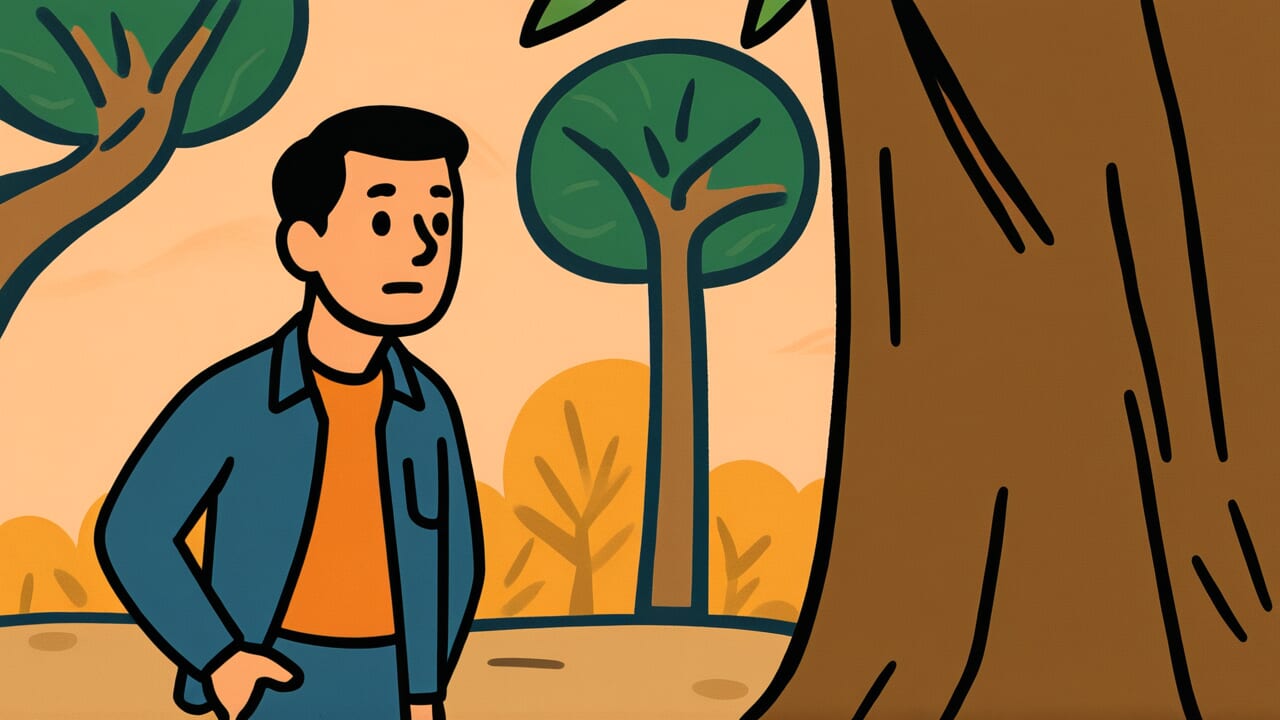How to Read “Don’t look up at a tree you can’t climb”
noborenai ki wa aogimiru na
Meaning of “Don’t look up at a tree you can’t climb”
This proverb warns against desiring or pursuing things that are completely beyond your abilities or circumstances.
No matter how long you stare up at a tree you can’t climb, you still won’t be able to climb it. Worse, you waste time and fill your heart with frustration and feelings of inadequacy.
People use this proverb to teach the importance of knowing your limits and setting realistic goals.
It helps people who are suffering from chasing ideals that are too high realize there might be better paths suited to them. It also warns those attempting reckless challenges.
Today, we understand this as advice to calmly assess your aptitudes and abilities, then set achievable goals.
Having dreams is important, but if they far exceed your capabilities, you may end up wasting your life. This proverb shares that practical wisdom.
Origin and Etymology
The exact first appearance of this proverb in literature is unclear. However, we can learn much from how the phrase is constructed.
The contrast between “a tree you can’t climb” and “looking up” forms the core of this proverb’s meaning.
Climbing trees has been closely connected to Japanese life since ancient times. People climbed trees to pick fruit, get a better view, or simply for fun.
Tree climbing was both practical and a way to prove your abilities. But not all trees can be climbed. Some are too tall, have thin branches, or have trunks too smooth to grip.
“Looking up” means more than just the physical act of raising your eyes. It carries feelings of longing and envy.
Continuing to gaze at something beyond your reach creates anxiety and dissatisfaction in your heart. This proverb likely emerged as a teaching against such pointless yearning.
The importance of having goals that match your station was wisdom shared across all levels of society, from samurai to common people.
In Japanese society, which valued the concept of knowing your proper place, this proverb was naturally accepted and passed down through generations.
Usage Examples
- He’s aiming for medical school, but with his weak foundation, “Don’t look up at a tree you can’t climb”—he should consider a more realistic path
- Trying to strike it rich with a startup is “Don’t look up at a tree you can’t climb”—let’s focus on building real skills in your current job first
Universal Wisdom
Humans naturally yearn for things beyond their reach. This quality is the source of ambition, but it also causes suffering.
This proverb has been passed down through generations because people have always faced this conflict.
There’s a certain sweetness to looking up at a tall tree. The hope of “maybe” or “someday” lets us escape from harsh realities.
But just looking up changes nothing. Time passes, and eventually you face yourself having gained nothing.
Our ancestors deeply understood this human weakness. That’s why they left us these words, both strict and kind.
“Don’t look up” doesn’t mean simple resignation. It means redirecting your gaze to an appropriate height.
Life offers countless trees. Rather than staring up at one you can’t climb, finding and actually climbing one you can brings far more fulfilling experiences.
And the experience of climbing one tree completely gives you strength to challenge the next one.
This proverb speaks a timeless truth about the balance between human desire and ability.
Knowing yourself and choosing appropriate goals is the path to true growth. This is universal wisdom.
When AI Hears This
This proverb puts into words a sophisticated self-defense system of the human brain.
According to psychologist Festinger’s cognitive dissonance theory, humans cannot tolerate the contradictory state of “wanting but not having.” Within seconds to minutes, they seek to resolve this discomfort.
There are two solutions: work hard to obtain it, or convince yourself you don’t want it. This proverb recommends the latter—preventive defense by “not looking in the first place.”
What’s interesting is that this approach prevents cognitive dissonance from occurring at all.
Aesop’s fox saw the grapes, jumped, couldn’t reach them, and only then convinced himself they were “probably sour anyway.” But this proverb suppresses the stage before dissonance arises—the emergence of desire itself.
In other words, it’s a strategy to look away before getting hurt.
However, this comes with a cost. Neuroscience research shows that human growth and creativity emerge from moderate cognitive dissonance.
By seeing unreachable goals, devising solutions, and sometimes failing, the brain creates new neural pathways. This proverb protects mental stability but also blocks opportunities for growth.
In essence, this is life wisdom showing the trade-off between psychological safety and growth potential.
Lessons for Today
This proverb teaches modern people the importance of self-awareness.
In today’s society, where we see others’ success on social media and live through constant comparison, we easily become captivated by goals beyond our abilities.
But true fulfillment comes from finding challenges suited to you and achieving them.
The key is not to receive this proverb as a word of “giving up.” Rather, it’s teaching you to develop the eye to identify which trees you can actually climb.
The world has countless trees, and there’s definitely one at the right height for you.
By finding it and actually climbing it, you gradually gain the strength to challenge taller trees.
Today, if you’re struggling with an unreachable goal, stop and think. Is that really the tree you should climb?
Might there be a path that’s more authentically you, where your strengths can shine?
Having the courage to know yourself and choose challenges that fit you—that’s the hope-filled message this proverb gives to those of us living in modern times.



Comments